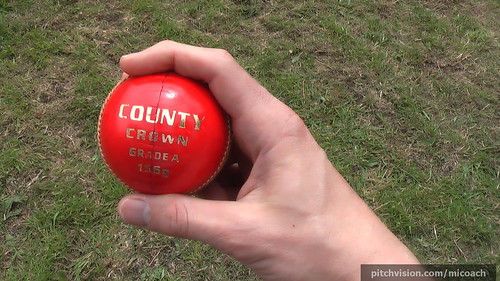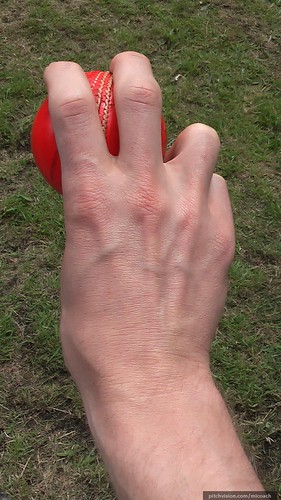Picture the scene. You are at the end of your run up. Conditions are in your favour and the ball has been swinging. Slips, gulley and the wicketkeeper are waiting.
You have been pitching the ball up a little further to encourage it to move but so far the batsman has been on top of you, hitting three drives through the gap at cover. He’s 12 not out.
You are not worried.
Your next ball is a beauty, moving late away as the batsman thinks he spies another boundary. The flashing drive in his mind catches the outside edge straight to second slip. You have your scalp for just 12 runs. Not a bad average so far...
That’s the art of swing bowling. When it works it’s incredible to watch. When it fails, it can be a disaster.
The basics of swing
A cricket ball swings because it has a seam. The air moving over the ball as you bowl it causes it to drift to the side. Very small adjustments in the position of the seam can lead to large movements. The outswinger moves from leg to off side, the inswinger moves from off to leg. The longer the ball is in the air, the more is swings. That means anyone can swing the ball no matter what their pace. In fact, the faster the bowler the less it swings.
To control which way the ball swings you start by adjusting the basic grip.

Basic grip. Here the seam is straight, pointing at the stumps when you deliver it.

Outswing grip. The seam has been turned towards slip (for a right handed batter). The wrist stays firm throughout.

Inswing grip. The seam is now turned towards fine leg (again for a right handed batter). The wrist is slightly less firm.
Seam position is most important. If it wobbles in the air you will not get the swing you are looking for. Ian Pont recommends making small adjustments to the seam position until you find swing but keep your wrist facing the batsman at the point of release.
The ball
How you look after the ball when bowling swing is important. The ideal ball for traditional swing is:
- Relatively new
- One side shined only
- Dry
- Clean
Everyone on the team has a duty to keep the ball as close to this condition as possible.The better condition the ball is in the more it will swing.
The tactics of swing bowling
Swing can be impossible to play but it takes some experimentation to get right because conditions do not always suit. The basic tactic is to pitch the ball up a a good length but close to a half volley around off stump. You are trying to encourage the batsman to want to drive, bringing in the slips and keeper (or bowl them through the gate with inswing). You may be hit for some runs if the ball does not swing early on, but keep experimenting with seam position.
If you bowl outswing too wide you are giving the batsman a sighter. If you bowl too straight the ball is less likely to swing and goes down the leg side. If you bowl too short the ball will not swing as much and the batsman can adjust more easily.
If the ball is not swinging, you can experiment with your position on the crease. Go wider or closer to the stumps to see if a change of angle helps. You can also change the pace of the ball. Sometimes going a little slower will make all the difference.
Sometimes the ball can swing too much giving the batsman time to leave it if it is not straight. You can counteract this by holding the ball across the seam. This will stop the ball swinging at all so you will need to find a new way to take wickets.
It’s a tightrope to walk and needs a forgiving captain who understands the fragility of swing. But if you understand your own methods and tactics you will be in a better position to take more wickets.